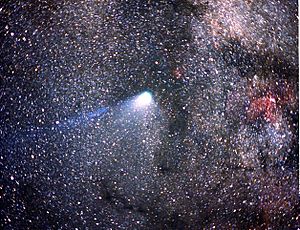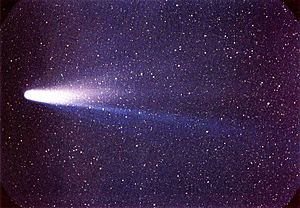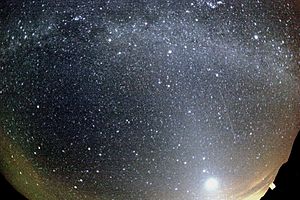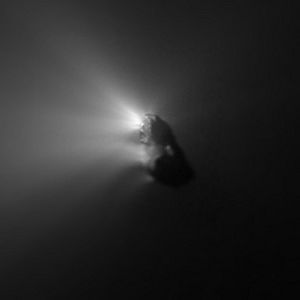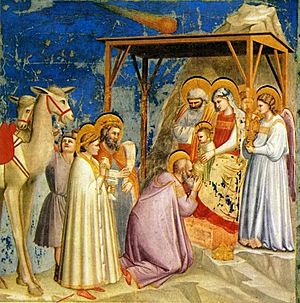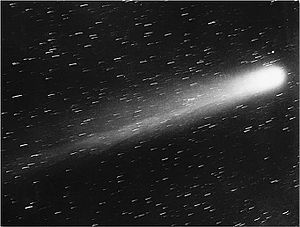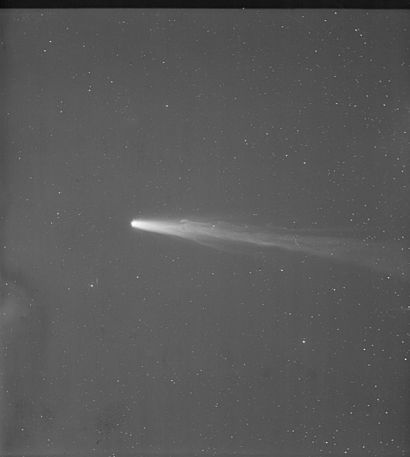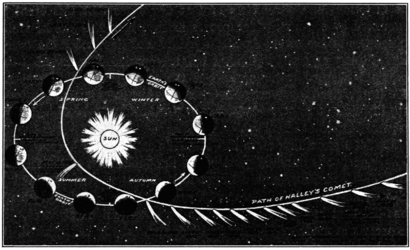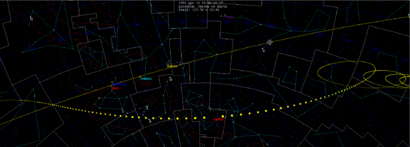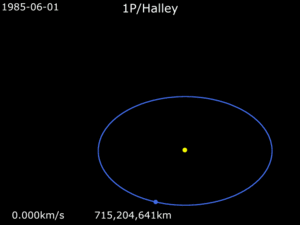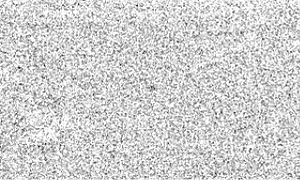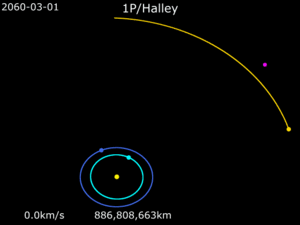Halley's Comet facts for kids
Halley's Comet is a famous comet that visits Earth's neighborhood about every 75 or 76 years. When it gets close enough, you can see it without needing a telescope! Its next visit will be in 2061.
When Halley's Comet last came close to Earth in 1986, several special spacecraft flew by to study it. The Giotto probe, sent by the European Space Agency, got the closest look at the comet.
The time it takes for the comet to complete its journey around the Sun can change a little. This is because the gravity of other planets can pull on it.
In 1986, Halley's Comet was the first comet ever studied up close by spacecraft. Scientists learned a lot about its nucleus (the solid center) and how its fuzzy cloud (called a coma) and long tail are formed. These observations helped confirm the "dirty snowball" idea, which said that comets are made of ice and dust. However, the missions also showed that Halley's surface is mostly dusty, not icy.
Halley's Comet: Its Path and Where It Comes From
Halley's Comet takes between 74 and 79 years to orbit the Sun. This has changed slightly over time. When the comet is closest to the Sun, it's called its perihelion. This point is about 0.59 au (88 million km) from the Sun, which is between the orbits of Mercury and Venus.
When the comet is farthest from the Sun, it's called its aphelion. This point is about 35 au (5.2 billion km) away, which is roughly the distance of Pluto.
Unlike most objects in our Solar System, Halley's Comet orbits the Sun in the opposite direction to the planets. Imagine looking down from above the Sun's north pole; the planets go counter-clockwise, but Halley goes clockwise!
Halley is known as a periodic or short-period comet. This means its orbit is 200 years or less. Other comets can take thousands of years to orbit. Scientists think that comets like Halley might have started as long-period comets. Then, the gravity of giant planets like Jupiter and Saturn pulled them into shorter orbits.
What Halley's Comet Is Made Of
The Giotto and Vega space missions gave scientists their first close look at Halley's surface. Like all comets, when Halley gets near the Sun, its icy parts (like water, carbon monoxide, and carbon dioxide) start to turn directly into gas. This process is called sublimation.
As the ice turns to gas, it creates a huge cloud around the comet's center, called a coma. This coma can be up to 100,000 kilometres (62,000 mi) wide! This process also releases tiny dust particles. The gas and dust then stream away from the comet, forming its visible tail.
The gas molecules in the coma glow when they absorb sunlight, a process called fluorescence. The dust particles also reflect sunlight. Both of these make the coma visible to us. Some of the gas in the coma gets electrically charged by the Sun's ultraviolet radiation. The solar wind (a stream of charged particles from the Sun) then pushes these charged particles into a long tail. This tail can stretch for more than 100 million kilometers into space! Sometimes, if the solar wind changes, the tail can even break off completely from the comet's nucleus.
Even though its coma is huge, Halley's nucleus (its solid core) is quite small. It's only about 15 kilometres (9.3 mi) long, 8 kilometres (5.0 mi) wide, and 8 kilometres (5.0 mi) thick. It looks a bit like a peanut shell. Its mass is low, and its density is about 0.6 grams per cubic centimetre (0.35 oz/cu in). This suggests it's made of many small pieces held together loosely, like a "rubble pile".
History of Halley's Comet Sightings
Early Sightings (Before 1066)
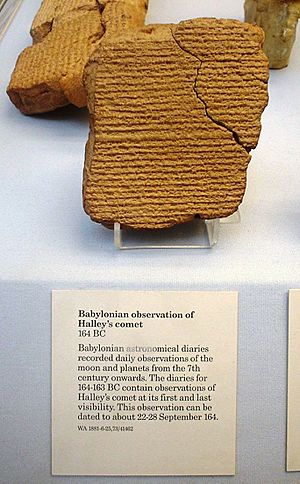
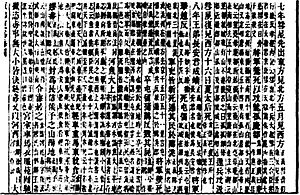
Halley's Comet might have been seen as early as 467 BC in ancient Greece. However, the first definite record of Halley's Comet is from 240 BC. It's described in a Chinese book called Records of the Grand Historian.
Ancient Babylonian tablets also record the comet's appearance in 164 BC and 87 BC. The 87 BC sighting might even be shown on coins of an Armenian king, Tigranes the Great, who wore a crown with a star and a curved tail.
In 837 AD, Halley's Comet came very close to Earth, possibly as near as 5.1 million kilometers (3.2 million miles). Its tail might have stretched halfway across the sky! Astronomers in China, Japan, Germany, and the Middle East all recorded this event.
The 1066 Sighting
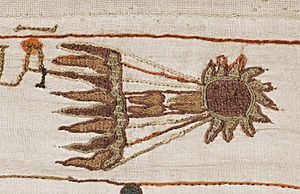
In 1066, people in England saw the comet and thought it was a bad omen. Later that year, King Harold II died in the Battle of Hastings, and William the Conqueror took the throne. The comet is even shown on the famous Bayeux Tapestry. People at the time said it looked four times bigger than Venus and shone as brightly as a quarter of the Moon.
Later Sightings (1145–1378)
The comet was seen in 1145 and recorded by a monk named Eadwine. Some people believe that the famous artist Giotto di Bondone saw the comet in 1301. He then painted the Star of Bethlehem as a fiery comet in his famous Adoration of the Magi painting, which he finished in 1305.
The 1456 Sighting
In 1456, when Halley's Comet appeared again, the Ottoman Empire was attacking the Kingdom of Hungary. Pope Callixtus III ordered special prayers for protection. A scholar named Bartolomeo Platina wrote that the Pope ordered prayers to turn any bad luck away from people and onto the "Turks, the enemies of the Christian name."
After seeing a bright light in the sky, which was likely Halley's Comet, Zara Yaqob, the Emperor of Ethiopia, founded a new city called Debre Berhan (meaning "City of Light").
Halley's Prediction (1531–1759)
| 1682 | 1759 | 1835 |
|---|---|---|
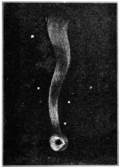 |
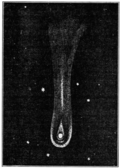 |
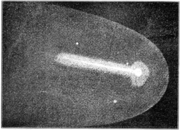 |
Since the 1500s, scientists have been studying Halley's Comet. A big step forward happened when Edmond Halley, an English astronomer, talked with Isaac Newton about his ideas on the laws of motion. Halley used Newton's ideas and records of the comet from 1531, 1607, and 1682. In 1705, he realized these were all the same comet and correctly predicted it would return in 1758. This was a huge achievement!
Halley also figured out why the comet's return time varied. He realized that the gravity of giant planets like Jupiter and Saturn could speed up or slow down the comet.
The 1910 Sighting
The comet's visit in 1910 was special for several reasons. It was the first time photographs of Halley's Comet were taken. Scientists also used new tools called spectroscopes to study its light. The comet came quite close to Earth then, making it a spectacular sight.
The 1986 Sighting
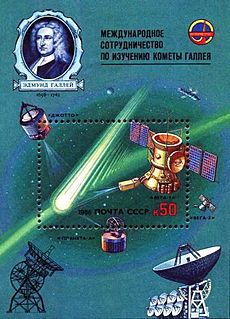
The 1986 visit of Halley's Comet was not the best for viewing from Earth. The comet and Earth were on opposite sides of the Sun for much of the time. Also, more light pollution from cities made it harder for many people to see it. Binoculars helped, especially away from city lights.
However, 1986 was a huge year for science! Several space probes were sent to study the comet up close.
- The Soviet Vega 1 probe sent back the first-ever images of Halley's nucleus on March 4, 1986.
- The Vega 2 probe followed shortly after.
- On March 14, the Giotto space probe from the European Space Agency made the closest pass to the comet's nucleus.
- Two Japanese probes, Suisei and Sakigake, also studied the comet.
Together, these probes were unofficially called the Halley Armada.
Other spacecraft also observed Halley. The Astron ultraviolet space telescope studied its coma. The International Cometary Explorer (ICE) also flew by, though not as close.
Two U.S. Space Shuttle missions were planned to observe Halley's Comet from space. Sadly, the STS-51-L mission ended in disaster when the Challenger exploded, killing all seven astronauts. Another mission, STS-61-E, was canceled because of this accident.
After 1986
On February 12, 1991, when Halley was far from the Sun, it suddenly had an "outburst." It released a huge cloud of dust, 300,000 km (190,000 mi) across! The comet became much brighter for several months.
Halley's Comet was last seen in 2003 by the Very Large Telescopes in Chile. It was incredibly faint then, but astronomers could still spot it. This shows how powerful modern telescopes are!
On December 9, 2023, Halley's Comet reached the farthest point in its orbit from the Sun. It was moving at its slowest speed then.
The Next Visits (2061 and 2134)
The next time Halley's Comet will be closest to the Sun is July 28, 2061. This will be a much better time to see it from Earth than in 1986. It will be on the same side of the Sun as Earth, making it easier to spot. It's expected to be quite bright!
Before its closest approach to the Sun, Halley will pass close to Jupiter in September 2060. Then, in August 2061, it will pass close to Venus.
After that, Halley's Comet will return again on March 27, 2134. On May 7, 2134, it will pass very close to Earth, and it's expected to be even brighter than in 2061!
Interesting Facts About Halley's Comet
- The comet is named after Edmond Halley (1656–1742), an English astronomer. He was the first to predict its return in 1705.
- Halley's Comet was the first comet ever recognized as "periodic," meaning it comes back regularly.
- It's the only comet you can see with your bare eyes that might appear twice in one person's lifetime.
- Halley's Comet has probably been in its current orbit for a very long time, possibly between 16,000 and 200,000 years.
- It is the most active of all the comets that return regularly.
- Some people have wondered if Halley's appearance in 12 BC, which was close to the time Jesus Christ was born, could be related to the biblical story of the Star of Bethlehem.
- The famous American writer Mark Twain was born just two weeks after Halley's Comet appeared in 1835. He famously said, "I came in with Halley's comet in 1835. It is coming again next year, and I expect to go out with it." He died on April 21, 1910, the day after the comet's next visit.
Images for kids
-
Observation of Halley's Comet, recorded in cuneiform on a clay tablet between 22 and 28 September 164 BC, Babylon, Iraq. British Museum
-
Report of Halley's Comet by Chinese astronomers in 240 BC (Shiji)
-
Possible report of Halley's Comet in the Talmud (MS Paris 1337).
-
1986 USSR miniature sheet, featuring Edmond Halley, Comet Halley, Vega 1, Vega 2, Giotto, Suisei (Planet-A)
Related pages
See also
 In Spanish: Cometa Halley para niños
In Spanish: Cometa Halley para niños


